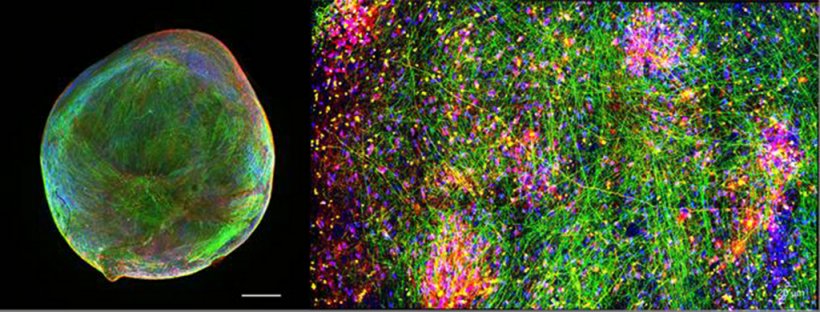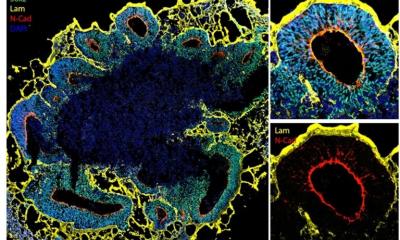
Figures from Zafeiriou et al. (2020) GABA polarity switch and neuronal plasticity in Bioengineered Neuronal Organoids. Nat Commun, 11, 3791.
News • Bioengineered Neuronal Organoids
Generation of human brain organoids with the ability to learn
Scientists combined induced pluripotent stem cells (iPSC) and their deep knowledge in the bioengineering of human organoids to for the first time bioengineer the human brain at the macroscale level with comprehensive network function
The brain is one of the most complex organs in the human body. Complexity of the brain is the result of highly and dynamically interconnected neurons as well as supporting glia. Lifelong changes in neuronal interconnectivity are key for memory and learning. Disturbances in neuronal interconnectivity are considered to be a possible cause of the clinical symptoms of neurodegenerative diseases.
Scientists from the Institute of Pharmacology and Toxicology at the University Medical Center Göttingen (UMG), in collaboration with colleagues from the Cluster of Excellence “Multiscale Bioimaging” (MBExC) and the German Center for Neurodegenerative Diseases (DZNE), have now succeeded for the first time in creating neuronal networks displaying the complex functions of the human brain from human induced pluripotent stem cells. These so-called Bioengineered Neuronal Organoids (BENOs) are thus suitable to study the loss of learning ability and memory in neurodegenerative diseases in more detail. Pharmacological and electrical stimuli were applied to confirm the classical developmental switch from an embryonic to a more advanced pattern of excitability. The results of this study have been recently published in the journal Nature Communications.
The scientists exploited an array of assays to decipher the developmental complexity down to the cellular level in BENOs and could demonstrate the presence of key components of the human brain. “It was truly exciting to observe processes, which underly memory and learning, known as neuronal plasticity, in our BENO model”, says first author Dr. Maria-Patapia Zafeiriou, scientist at the Institute of Pharmacology and Toxicology, and member and application specialist at the MBExC. Prof. Dr. Wolfram-Hubertus Zimmermann, senior author, director of the Institute of Pharmacology and Toxicology and member of the MBExC adds “This first evidence for complex, physiological function in a lab-grown brain organoid will be further explored to study mechanisms and innovative therapies for degenerative diseases of the brain, such as stroke, epilepsia, and dementia”.
BENOs and first applications
BENOs are already finding initial applications in disease modelling, for example epilepsy syndromes, and drug testing. The availablity of induced pluripotent stem cells as the starting material for BENOs allows for the creation of BENOs from literally every individual, healthy and diseased. This opens the door for the development of patient-specific therapies. “This not only opens the door to the development and preclinical testing of individualised procedures directly on the human model. In principle, it will also be possible to cultivate replacement tissue for the treatment of patients suffering from neurodegenerative diseases,” says Prof. Dr. Zimmermann.
Although our understanding of the human brain remains incomplete and, accordingly, therapeutic approaches to prevent or repair degeneration are largly insufficient, the availability of brain organoids with a cellular composition and function similar to the human brain will advance our understanding of how the human brain develops and functions properly as well as what causes neurodegeneration. The authors anticipate that the introduction of the BENO technology will support the search for innovative cures for todays most debilitating brain diseases. The University Medical Center Göttingen has filed a patent to protect the BENO technology and has licensed it to myriamed GmbH, a spin-off from the University Medical Center Göttingen, with a focus on drug discovery.
Source: University Medical Center Göttingen
31.08.2020








